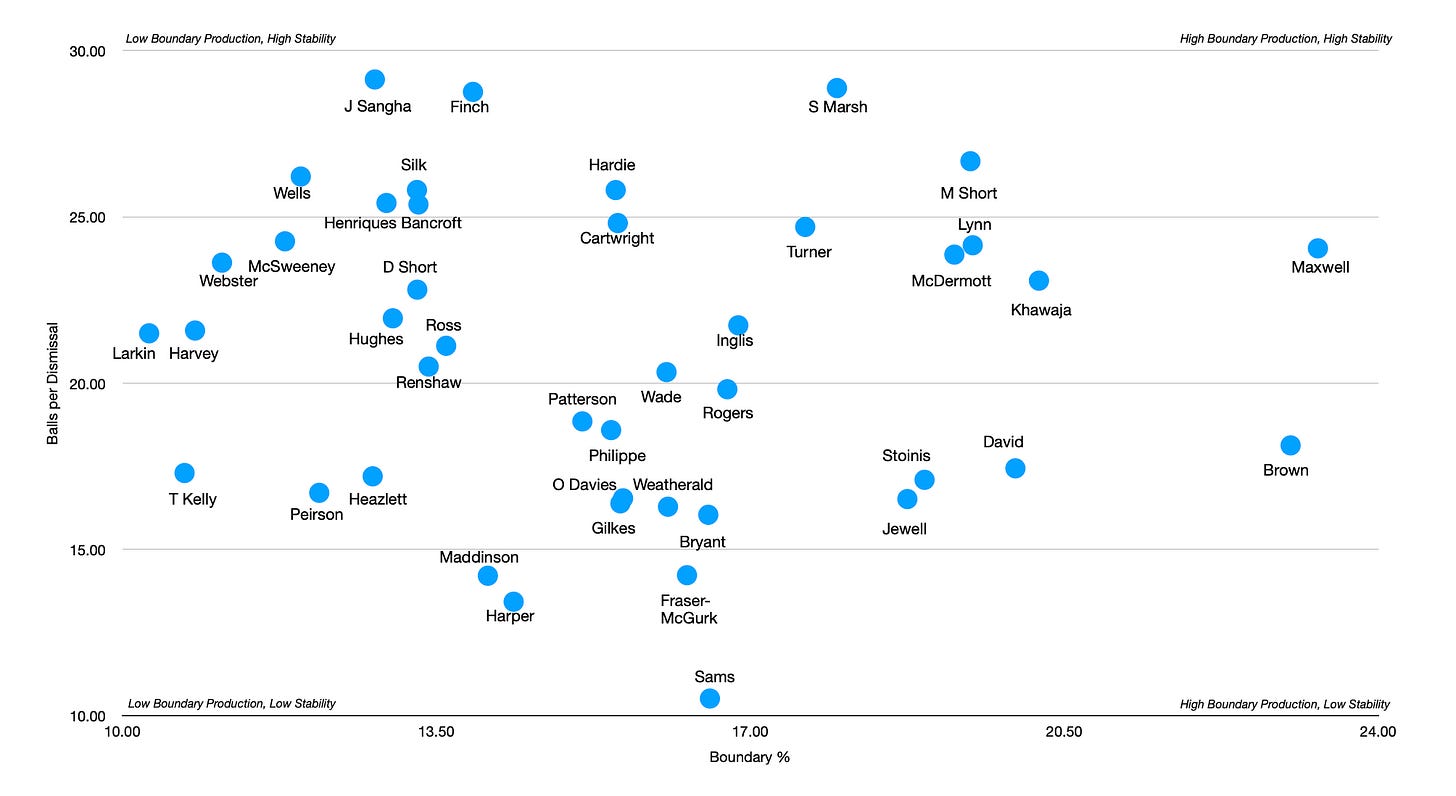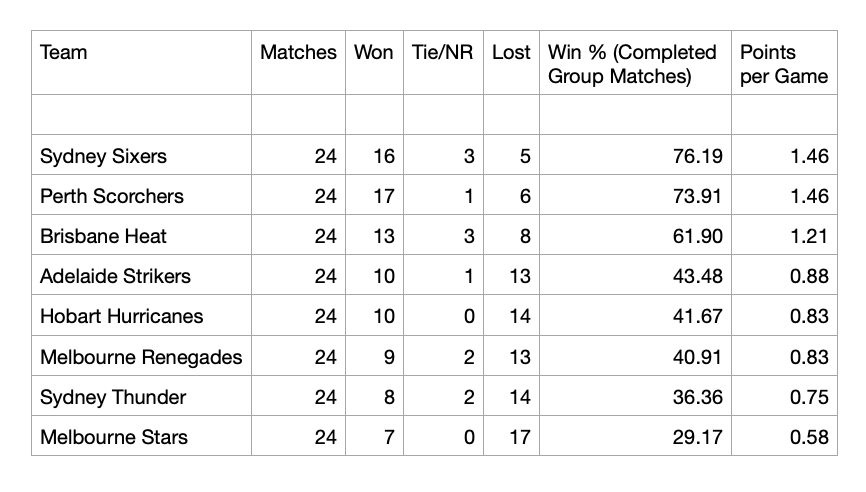A look at how the Big Bash & some underperforming teams can improve
Complete polarization between the best and worst teams in the tournament...
Congratulations to the Brisbane Heat for winning the 2023-2024 edition of the Big Bash yesterday, getting past Sydney Sixers in the final in an eventually dominant display.
While the shortened tournament has attracted good fan support and generally positive feedback on social media this year, there are still issues to be ironed out in future seasons.
Continued availability of overseas players & the defection of high-profile players to other T20 tournaments such as the ILT20 and SA20 during the Big Bash.
Overseas recruitment in general with Sydney Thunder in particular failing to make the most of their overseas quota.
A lack of general availability of Australian national team players.
Too many batters with low intent levels who despite this, consistently get picked by their teams.
Severe polarization between the best and worst teams in the tournament.
The above factors contribute to a general drop-off in standard as the tournament progresses, with teams in the knockout stages forced to pick players who had featured either rarely or not at all during the group stages.
Alleviating the overseas players (issues 1&2) shouldn’t be too difficult, with several options appearing reasonable. Firstly, one option would be to move back towards a direct recruitment model as opposed to the draft, which would allow Big Bash teams the opportunity to recruit players in advance of competing T20 leagues taking place at the same time being able to do so. Once the player signs for a Big Bash team, they would agree to be committed to the league for the entirety of the competition and can only play other leagues once their Big Bash commitments are complete.
Alternatively, if a draft-based recruitment mechanism be desired, the draft could be held much earlier - critically before the SA20 auction and before ILT20 teams get organized with their recruitment. For example, the draft for The Hundred takes place in March, with the tournament taking place 4-5 months later. What would be stopping Big Bash teams holding a draft, say, in May or June as opposed to the start of September?
It would also be worth considering creating a rule whereby a player must guarantee their full availability for the entire tournament to be accepted into the draft.
None of these options requires more money to be thrown at players, but can address the issues surrounding overseas availability without too much difficulty.
Issue 3, surrounding the national team players, is probably the most difficult to rectify. Generally speaking, the. highest quality short-format leagues ensure that their international players are fully available, and we’ve seen the benefits of this recently with the SA20 league, which has really captured the imagination of the public in South Africa.
Ultimately, this is a national team board decision, but demands of Test cricket and T20 leagues are becoming more and more mutually exclusive, and an approach trying to manage contrasting objectives is becoming increasingly unrealistic.
Moving on to issue 4, it is a continued surprise that in a country where cricket is a major sport, in conjunction with a successful national team, that there appears to be a real lack of above-average boundary hitters.
Yes, the boundaries are a bit bigger in Big Bash venues compared to say, some T20 Blast or IPL venues, but when a player can come out of nowhere such as Josh Brown and become the second-best boundary-hitter in recent years, and the likes of Glenn Maxwell can hit not far off a boundary every four balls faced in the tournament, boundary-hitting is not an insurmountable problem if a batter has both power and an attacking mindset.
Here’s a look at boundary percentage versus balls per dismissal for domestic batters facing 250+ balls in the Big Bash when batting in the top seven, across the last three editions of the tournament:-
The sheer number of batters hitting at around 14% boundaries or below is pretty much unparalleled in any other major T20 league. A question I would like to ask those people currently running BBL teams is why these players continue to get selected, and in some cases, continue to be awarded relatively high value contracts.
Of the players in the chart above registering 14.5% boundaries or below, here’s a breakdown of their current teams:-
This is an interesting breakdown of teams. Despite Scorchers historical reputation of being a bowling-strong team, they clearly also value some attacking intent with the bat. Hurricanes the same, although it should be noted that their overseas recruitment has been very disappointing over the last couple of years.
Sixers are an interesting case study. Henriques, Hughes and Silk contributed to the 29 appearances this year of low-boundary percentage batters, but what Sixers have done extremely well is ensure that their non-boundary run production is off the charts compared to their rivals. For example, their non-boundary strike rate as a team is more than 10 runs per 100 balls greater than the Hobart Hurricanes - it reminds me of the dynamic which Gujarat Titans have been successful with in the IPL.
Renegades topped the list of number of players featuring in the below-average boundary-hitting bracket (four), suggesting that they need some significant overhaul of their list, particularly considering several of these players are, or have been, senior players for them, presumably on high value salaries.
It’s also interesting to see Stars being tolerant of these type of players, perhaps being rather different to their reputation of being a big-hitting team filled with high profile players. Their ‘galactico’ approach shows little sign of being successful.
I’ve gone on record a number of times saying that the sheer number of players with markedly below-average boundary-hitting numbers has made me think that there must be better options out there. The success of several new players of late, such as Josh Brown and Nikhil Choudhary, suggest that there is some degree of untapped talent out there.
This is why I was so pleased to see Brisbane Heat win the Big Bash yesterday. Queensland Cricket have created the T20 Max tournament, with the intention of finding such untapped talent. They’ve been rewarded with the success of individual players (Brown and Spencer Johnson) and also the trophy as well.
Here’s a little more insight on this via Nick Stuart on Linkedin:-
If I was in charge of a Big Bash team, this method of identifying talent would be one of the first things I’d implement. I’d much rather give opportunities a raw hitter with a high ceiling like Brown in his first year last season than persist with batters who either lack the skillset or willingness to play an attacking brand of cricket.
A state T20 tournament enables both video and data analysis of a far bigger player pool of potentially low-profile talent. These players would likely be both cheap and very keen to have opportunities, which is a win-win for roster construction.
It would be possible, for example, with several years of data, for me to model the transition of standard from, say, the T20 Max in Queensland (or any other state-run T20 tournament) to the Big Bash. The same could be done for domestic 50 over tournaments too.
This data would then enable me to yield expected performance data for each player participating in these events, and while there are no guarantees with recruitment or the ability of a player to move up a level, what it would achieve would be to eradicate the basic list management mistakes which many Big Bash teams currently make. At this point in time, even an ability to do that would be an extremely beneficial investment for BBL teams.
The final issue focuses on the polarization of records for teams in recent years in this tournament. I have what I call a ‘60/40’ rule, and I’ve written about it a lot of times in the past. Essentially, the 60/40 rule is this:-
In a T20 competition without wildly different budgets (e.g. T20 Blast in England), any team winning 60% or greater of their matches over a decent period of time is doing extremely well. Conversely, any team winning 40% or less is doing extremely badly.
The overwhelming majority of T20 teams across leagues over a few seasons fall between the 40-60% win rate, so are neither outstanding or badly struggling. However, across the last couple of seasons in the Big Bash, there is an extreme polarization in team results rarely witnessed in other leagues:-
There is such a vast difference in the top three teams win percentages and points per game compared to the other five teams - as said, rarely witnessed in T20 leagues. This again illustrates how much work some teams have to do in order to become more competitive in the Big Bash - both short-term (improved list management and strategy) and long-term (finding untapped talent through trials, state-run T20 leagues etc).
Certainly the Melbourne-based teams do not come out of these results very well. Since the Renegades success with current Australia head coach Andrew McDonald as coach, where the team performed much greater than the sum of its parts, it has been a miserable few years for the team since McDonald moved on. Stars haven’t fared well either, with a squad that promises so much before tournaments but has typically fallen short of those expectations.
Thunder didn't even deign to pick a third overseas player in their squad at any time during the tournament, while in my view, Hurricanes overseas recruitment has been a big factor in their underperformance. Strikers seem to be a team who have a very mixed-ability group, with some top performers mixed with a number of below-average players as well.
It is my view that these five teams in particular can make some very quick on-pitch gains with an overhaul of their list management, analytics and strategic decision-making. Anyone interested in discussing how I can help their team with strategic consultation and data-driven analysis, or contribute to any media work, can get in touch at sportsanalyticsadvantage@gmail.com.




